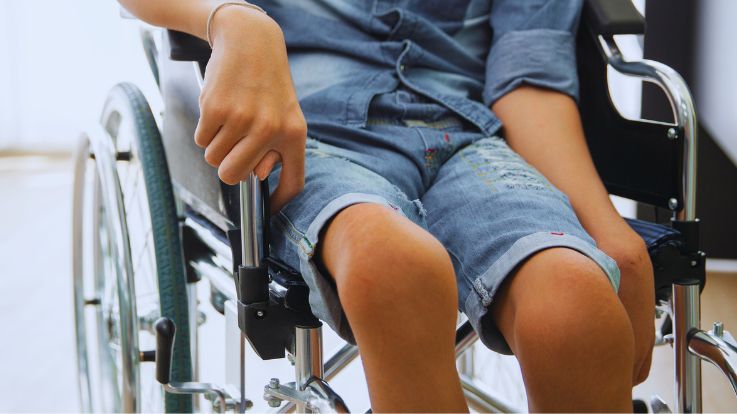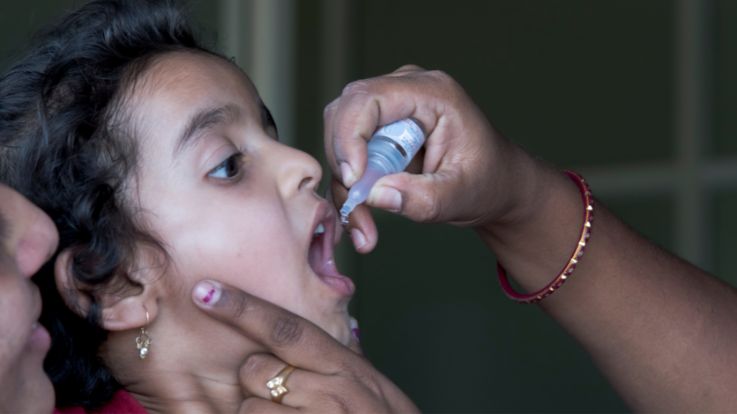Raising Awareness About P ...
Raising Awareness About Polio: Types, Causes, Symptoms And Prevention

Only For Pro
Reviewed by expert panel
The global incidence has lowered by almost 99 percent since 1988, primarily owing to the launch of the Global Polio Eradication Initiative by the World Health Assembly, which was spearheaded by national governments and international bodies like UNICEF and WHO. This has helped to completely eradicate 2 of the 3 types of wild poliovirus - type 2 in 1999 and type 3 in 2020. Type 1 poliovirus has not been eradicated yet, and though uncommon, its incidence is still cause of concern. Polio can be prevented with the help of vaccination, hence it is pertinent to raise awareness. Read this blog to know more.
What Is Polio?
More Similar Blogs
Polio or poliomyelitis, is a highly infectious disease caused by a virus belonging to the Picornaviridae family. It was responsible for causing paralysis in hundreds and thousands of children across the globe for years. The debilitating, and often life-threatening disease is caused by poliovirus and it commonly affects children under the age of 5 years. The virus can enter the nervous system and trigger serious complications. Irreversible paralysis is seen in almost 1 out of every 200 cases and out of these 5 to 10 percent die owing to loss of mobility. Poliovirus has three variations WPV1 (Wild poliovirus 1), WPV2 (Wild poliovirus 2), and WPV3 (Wild poliovirus 3). WPV2 and WPV3 have been eradicated whereas WPV1 still exists.
As per the World Health Organization, “As long as a single child remains infected, children in all countries are at risk of contracting polio. Failure to eradicate polio from these last remaining strongholds could result in a global resurgence of the disease.”
Types Of Polio
Polio can be classified into several different types depending on the part of the body that it attacks. These are:
Abortive Poliomyelitis
It is the most common and mildest form of polio, accounting for merely 5% of the cases. It is characterised by symptoms similar to those triggered by flu, and these can last for 2 to 3 days. Some patients may also experience intestinal symptoms.
Nonparalytic Poliomyelitis
It is a rare yet more severe form of polio that accounts for around 1% of the cases. The symptoms are similar to but a little more severe than flu and tend to last for a longer span of time. As the name suggests, nonparalytic polio does not cause paralysis however, in some cases, the symptoms may return after the patient starts getting better.

Paralytic Poliomyelitis
It is the most dangerous but rarest form of polio that initially develops like nonparalytic poliomyelitis, but gradually attacks the brain and spinal cord, paralysing the muscles involved in crucial functions like breathing, speaking, swallowing, and moving limbs. Depending on the parts of the body that have been affected, paralytic poliomyelitis can be further classified into two types - Spinal polio and Bulbar polio. If a person has both of these, it is known as Bulbospinal polio.
Causes Of Polio
Polio is caused by naturally occurring poliovirus, known as wild-type poliovirus which is known to attack the nerve cells found in the brain and spinal cord. Whether a person is symptomatic or asymptomatic, he/she can pass the virus along with stools. Some might even release them while coughing or sneezing. The use of water contaminated with the faecal matter of an infected person may also lead to the spread of polio.
A new version, VDPV (Vaccine-Derived Poliovirus) has been found recently and the cases are mostly reported from the Democratic Republic of Congo and Syria. The oral poliovirus contains the three attenuated strains of polio, however in rare cases, if the child has a compromised immune system, the virus can mutate and multiply in the child’s intestine.
VDPV is even more rare, however, it is still a cause of concern as it poses a potential threat of spread. This is broadly classified into three types:
-
iVDPV (Immunodeficiency-Related Vaccine-Derived Poliovirus), which is found in people who are immunocompromised by birth or become immunocompromised after being born.
-
Circulating vaccine-derived poliovirus (cVDPV), which is found in communities owing to the spread of VDPV
-
Ambiguous vaccine-derived poliovirus (aVDPV), which refers to cases that cannot be clearly classified as iVDPV or cVDPV
Case Study Of iVDPV
In a collaborative study conducted by ICMR-National Institute of Virology, Mumbai Unit, ICMR-National Institute of Immunohaematology, and World Health Organization, India, the faecal samples of babies born with inborn errors of immunity (IEI) were screened. A seven-month-old baby boy from Kerala, who had received 2 doses of OPV, was found to have iVDPV type 1. Faecal samples of the parents were also collected and while the mother tested negative, it was found that the father too had traces of iVDPV, despite being asymptomatic. Doctors performed a haploidentical hematopoietic stem cell transplant to save the child but lost him after 3 weeks.
Polio Risk Factors
The risks of developing polio are higher in
-
Children under the age of 5
-
Young kids who are not properly toilet-trained
-
People who are immunocompromised
-
Women who are pregnant
-
People who travel to areas where polio still persists
-
People who live in areas with poor sanitation
It is pertinent to note that while polio is commonly seen in kids, it can also affect adults who were not vaccinated as children.
Symptoms Of Polio
Polio can manifest in a variety of ways based on the severity of the symptoms. As per the National Library of Medicine, “The majority of exposed patients (around 95%) are asymptomatic”. This means that 95 percent of the patients do not experience any symptoms at all. However, the virus is shedded along with stools and can be traced easily from the stool sample of the suspected person.
Symptoms Of Abortive Poliomyelitis
-
High fever (up to 103º F)
-
Sore throat
-
Headache
-
Loss of appetite
-
Nausea/vomiting
-
Constipation
-
Abdominal discomfort
Symptoms Of Nonparalytic Poliomyelitis
-
Severe headache
-
Nausea/vomiting
-
Recurring symptoms
-
Neck pain/stiffness
-
Muscle Pain
-
Body stiffness
Symptoms Of Paralytic Poliomyelitis
-
Muscle weakness/wasting
-
Hyperesthesia or increased sensitivity to touch
-
Muscle spasms
-
Twitching
-
Tingling sensation
-
Intense pain
-
Severe constipation
-
Limb paralysis
Can Polio Come Back? (Post Polio Syndrome)
Yes, polio can come back in some of the cases. Post-polio syndrome or PPS is a condition marked by the gradual loss of muscle in people who’ve had polio in the past. While most people with polio are asymptomatic, some may experience temporary symptoms or symptoms that stop aggravating after some span of time. In the case of post-polio syndrome, the symptoms may either come back or again start aggravating after a couple of weeks, months, or even years. PPS is characterised by symptoms like extreme fatigue, muscle atrophy, muscle pain, joint pain, and sleep apnoea.
It is important to note that not every person with polio will develop PPS and it generally happens after a span of 15 years or more.
Polio Prevention
“The development of effective vaccines to prevent paralytic polio was one of the major medical breakthroughs of the 20th century. The Global Polio Eradication Initiative uses two types of vaccine to stop polio transmission – inactivated polio vaccine (IPV) and oral polio vaccine (OPV)” - Polio Global eradication initiative

The Inactivated Injectable Polio Vaccine was developed by Dr Jonas Salk in 1955. It was a combination of inactivated strains of all 3 subtypes of poliovirus. Dr Albert Sabin came up with a new version in 1961, Oral Polio Vaccine. This is to be taken orally and is made up of a combination of attenuated strains of the 3 subtypes of poliovirus
We spoke to Dr. Chetan Tatrari about the prevention and risk control of iVDPV. He shared that the risks can be managed by “using bivalent OPV instead of trivalent OPV, Serial screening of immunocompromised individuals for poliovirus and preventing feco-oral transmission from poliovirus excreting patients by adopting strict measures”
“Pocapavir, a new agent against poliovirus, is available, but limited data is available on its efficacy” he added.
Polio Eradication Strategy 2022-2026
Proper implementation of polio eradication strategies in the past has helped to eradicate the disease in many parts of the world. Polio Eradication Strategy 2022-2026 replaced the earlier eradication strategy - Polio Endgame Strategy 2019-2023 in January 2022.
“The strengthened plan aims to achieve and sustain a polio-free world through a focus on implementation and accountability. Emphasis will be on cutting outbreak response times; increasing vaccine demand; transforming campaign effectiveness; working systematically through integration; increasing access in inaccessible areas; transitioning towards government ownership; and improving decision-making and accountability.” - Polio Eradication Strategy 2022-2026
How is polio diagnosed?
If a person is presenting with signs of polio, doctors perform a physical evaluation, followed by an examination of the patient’s faeces, cerebrospinal fluid, or throat specimen. The last one is considered less reliable owing to the fact that poliovirus lives in the throat for a week. The virus may either be isolated in the cell culture or with the help of polymerase chain reaction (PCR).
How is polio treated?
As of now, there is no known cure for polio, making it even more important to emphasise prevention. Doctors may recommend heat and physiotherapy for stimulating the muscles and antispasmodic drugs may be prescribed for helping the muscles relax.
FAQs
Q1- Is there a cure for polio?
No, as of now, there is no cure for polio.
Q2- Is polio contagious?
Yes, polio is highly contagious and can easily spread from one person to another through faecal contact. It can also spread by sneezing and coughing.
Q3- How many doses of polio are given to a child?
Every child needs a minimum of 3 doses at 6, 10, and 14 weeks followed by booster doses at 16-18 mo and at 4-6 years of age
Q4- How many types of polio vaccines are available?
There are 2 types of polio vaccines available - inactivated polio vaccine (IPV) and oral polio vaccine (OPV)
Sources
Be the first to support
Be the first to share
Comment (0)




